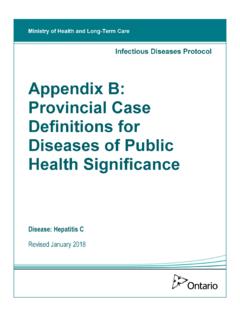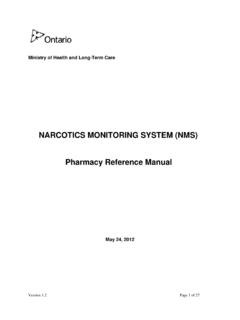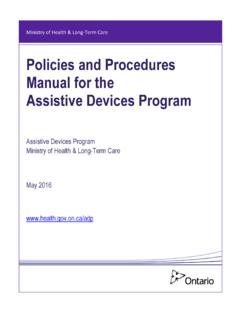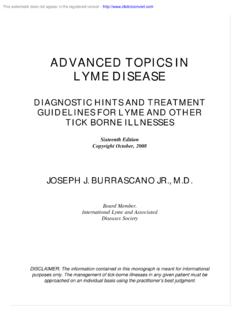Transcription of Combating Lyme Disease Through Collaborative Action
1 Ministry of Health and Long-Term Care Combatting lyme Disease Through Collaborative Action Ontario s 10-Step Education and Awareness Plan July 2016 Ministry of Health and Long-Term Care Copies of this report can be obtained from INFO line: 1-866-532-3161 TTY 1-800-387-5559 Table of Contents Message from the Minister of Health and Long-Term Care .. 5 About this 10-Step Education and Awareness Plan .. 6 Our 10-Step Education and Awareness Plan Supports Patients First .. 7 ACCESS .. 7 CONNECT .. 7 INFORM .. 7 PROTECT .. 7 Taking Stock: lyme Disease in Ontario .. 8 What is lyme Disease ? .. 8 Symptoms .. 9 Testing, Diagnosis and Treatment .. 10 Where Am I at Risk? .. 11 Removing a Tick in 4 Easy Steps .. 1210-Step Education and Awareness Plan for lyme Disease .
2 13 ACCESS .. 13 CONNECT .. 15 INFORM .. 17 PROTECT .. 18 Next Steps .. 20 What Can You Do? .. 20 For More Information .. 21 General Inquiries .. 21 Media Inquiries .. 21 Educational Resources .. 21 Combatting lyme Through Collaborative Action Ontario s 10-Step Education and Awareness Plan5 Message from the Minister of Health and Long-Term Care Combatting lyme Disease Through Collaborative Action : Ontario s 10 Step Education and Awareness Plan is the first step in the Ontario government s efforts to prote ct the people of Ontario from lyme Disease . The Ontario government has been working with its partners in public health and with other stakeholders to make sure tha t Ontarians and the health care providers they rely on have the information they need abou t lyme Disease .
3 Ontario is also working to ensu re patien ts have access to the bes t evidenced-based care options we can provide. Whether you live in a high-risk area or may be travelling to one all Ontarians need to be aware of lyme Disease . As part of Ontario s Patients First: Action Plan for Health Care we made a commitment to the people of Ontario to provide the education and information they need to make the right decisions about their health. Our 10-Step Education and Awareness Plan on lyme Disease will provide you with t he information you need about lyme Disease and outline the step s ou r government is taking to protect Ontarians from the Disease . Together with all of our partners Ontario rema ins committed to putting peop le and patien ts first as we strive to mee t the challenge of lyme Disease .
4 Dr. Eric Hoskins Minister Health and Long-Term Care 6 About this 10-Step Education and Awareness Plan Every spring, Ontarians head outside to explore all the natural beauty that our province has to offer. Recreational activities such as camping, fishing, hiking, golfing and hunting make our province second to none in providing the perfect backdrop for keeping fit and healthy while enjoying the fresh air and natural surroundings. Whether taking part in recreational activities, working outdoors, living in rural areas or travelling abroad Ontarians are encouraged to include the prevention of tick bites that can lead to lyme Disease in their plans. lyme Disease is a public health concern that exists not only in Ontario but also across North America, Europe and Asia.
5 lyme Disease threatens the health of Ontario residents last year there were approximately 400 reported cases in Ontario. The symptoms of lyme Disease may appear minor at first. However, if left untreated, lyme Disease can have a devastating impact on individuals, families and communities. The Ontario lyme Disease Education and Awareness Plan focuses on protecting us all from lyme Disease . At its core, this Plan is a roadmap for improving awareness, education, prevention and control of lyme Disease in Ontario. This Plan builds on the efforts of the many agencies, communities and individuals who are already doing so much in the field of lyme Disease and advocating on behalf of patients. 7 Our 10-Step Education and Awareness Plan Supports Patients First This Plan supports Patients First: Action Plan for Health Care, Ontario s plan for changing and improving its health system.
6 Patients First exemplifies our commitment to put people and patients at the centre of this strategy by focusing on four pillars: ACCESS 1. Improve the availability of the information, tools and supports people need when and how they need them 2. Strengthen intergovernmental co-ordination of lyme Disease initiatives and prevention 3. Support the availability of consistent signage and information at all provincial parks in risk areas CONNECT 4. Engage a broad range of voluntary and non-governmental groups/organizations 5. Facilitate effective patient-health care provider interactions about care, treatment and support options available INFORM 6. Launch a comprehensive, province-wide awareness and education campaign 7.
7 Expand health care provider education to strengthen the focus on care, treatment and support PROTECT 8. Increase awareness of lyme Disease risk areas and the possibility of infected ticks being found outside known risk areas 9. Review and update Public Health Ontario s Technical Report on lyme Disease prevention and control 10. Contribute to the development of an Ontario lyme research agenda 8 Taking Stock: lyme Disease in Ontario What is lyme Disease ? In Ontario, lyme Disease is caused by Borrelia burgdorferi bacteria. In other jurisdictions, different species and strains of Borrelia bacteria have been known to cause lyme Disease . In Ontario, this bacterium is passed to humans Through the bite of infected blacklegged ticks which are also known as deer ticks.
8 The transmission of the bacteria from an infected tick to a human is thought to usually take at least 24 hours. Early in their life cycle, ticks are as small as the period at the end of this sentence. At the nymph stage, when they are most likely to infect humans and animals, they can be as small as the size of the head of a pin- and it is this small size that makes them easy to overlook on the body (see image 1). A bite may occur without being noticed. The most effective way to prevent lyme Disease is to prevent tick bites. Image 1: Ticks at different stages of life cycle (Photo courtesy of the Public Health Agency of Canada)9 Symptoms The most commonly known symptom of lyme Disease is the appearance of an expanding, mildly-itchy to non-itchy rash (called an erythema migrans rash).
9 The rash begins at the site of the tick bite between three to 30 days after exposure and usually grows in size for several days before it begins to fade and eventually disappears. It is important to know however, that not everyone gets a rash and that even if they do a person may not notice one if it is on a hard-to-see part of the body. If there is a rash it s advisable to take (and date) photos with a tape measure beside the rash to determine the size. Flu-like symptoms, fatigue, fever, headaches, swollen glands as well as muscle and joint pain are a few of the most common early signs of lyme Disease . If the Disease is left untreated many other symptoms may also develop in the weeks to months following exposure.
10 These symptoms could potentially last for years and may include: additional rashes, joint pain and swelling, neurological problems, shooting pains, numbness and tingling, balance and/or memory difficulties, dizziness and heart palpitations, severe headaches, loss of muscle tone in the face (resembling Bell s palsy) and paralysis, among others. Although uncommon, deaths from lyme Disease have been reported. Note 1: Protecting Yourself from Tick Bites In Ontario, black legged ticks that carry lyme Disease live in woodlands, tall grasses and bushes. If you spend time in these areas and an infected tick bites you it may pass the Disease on to you. Protect yourself in the following ways: Wear light-coloured clothing.


















